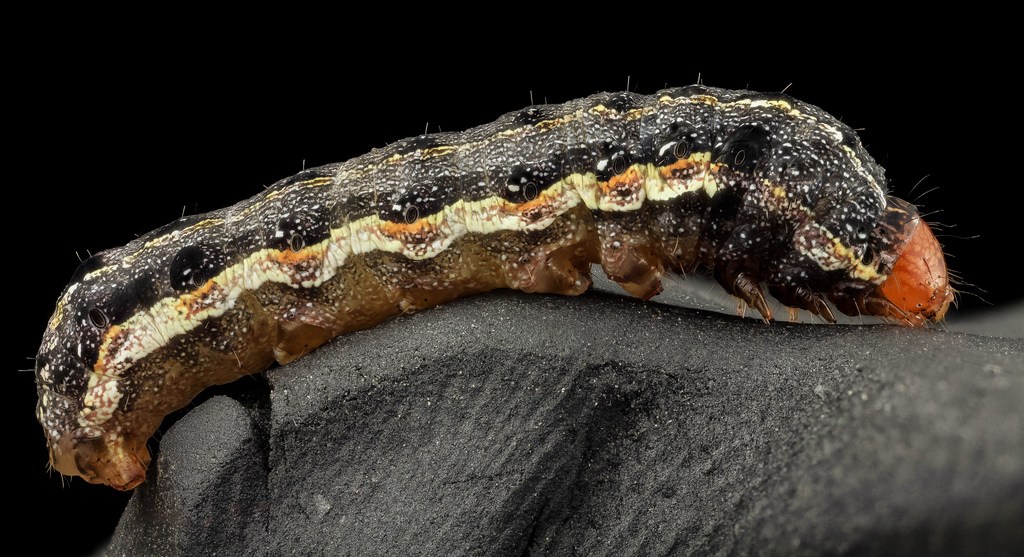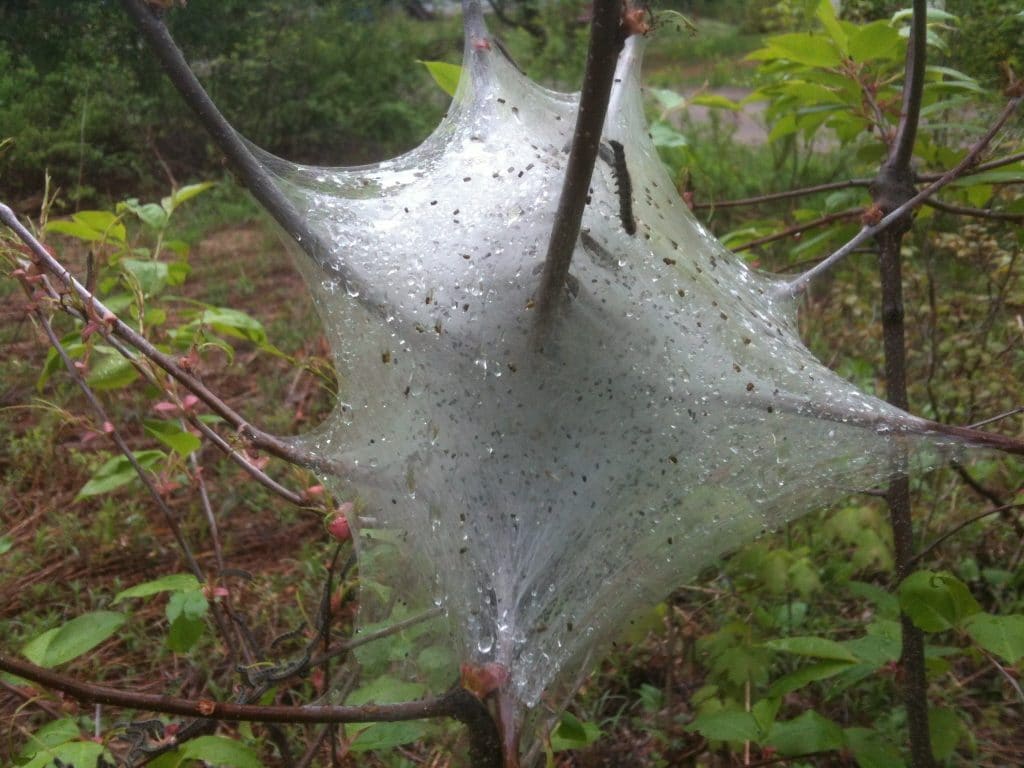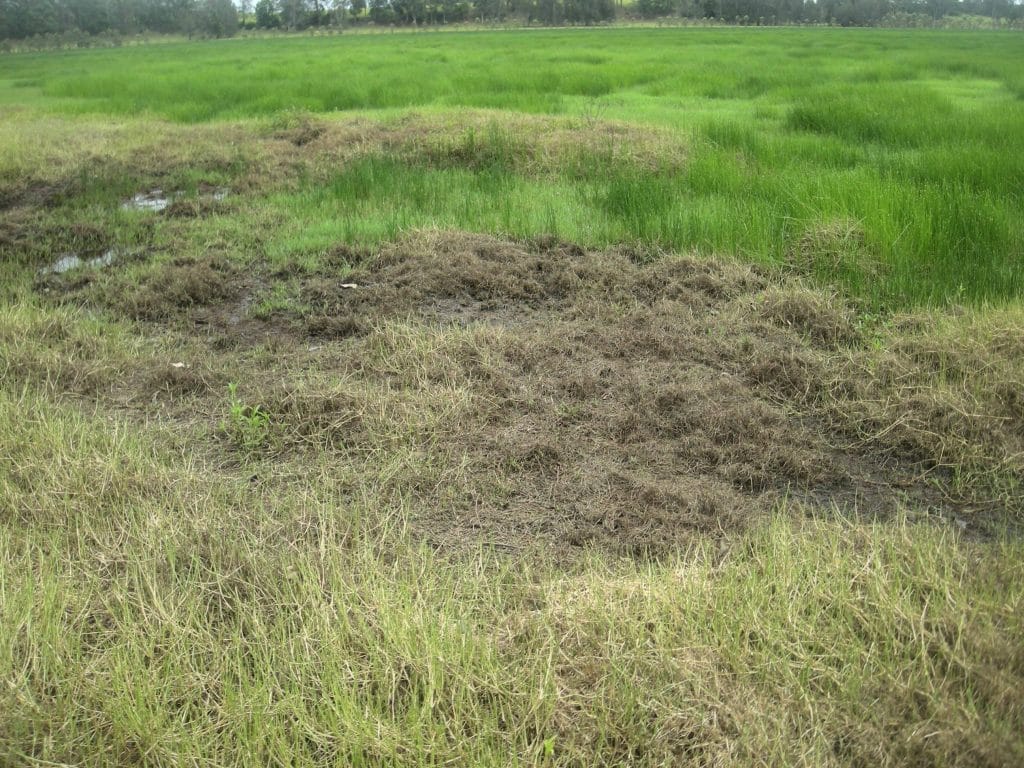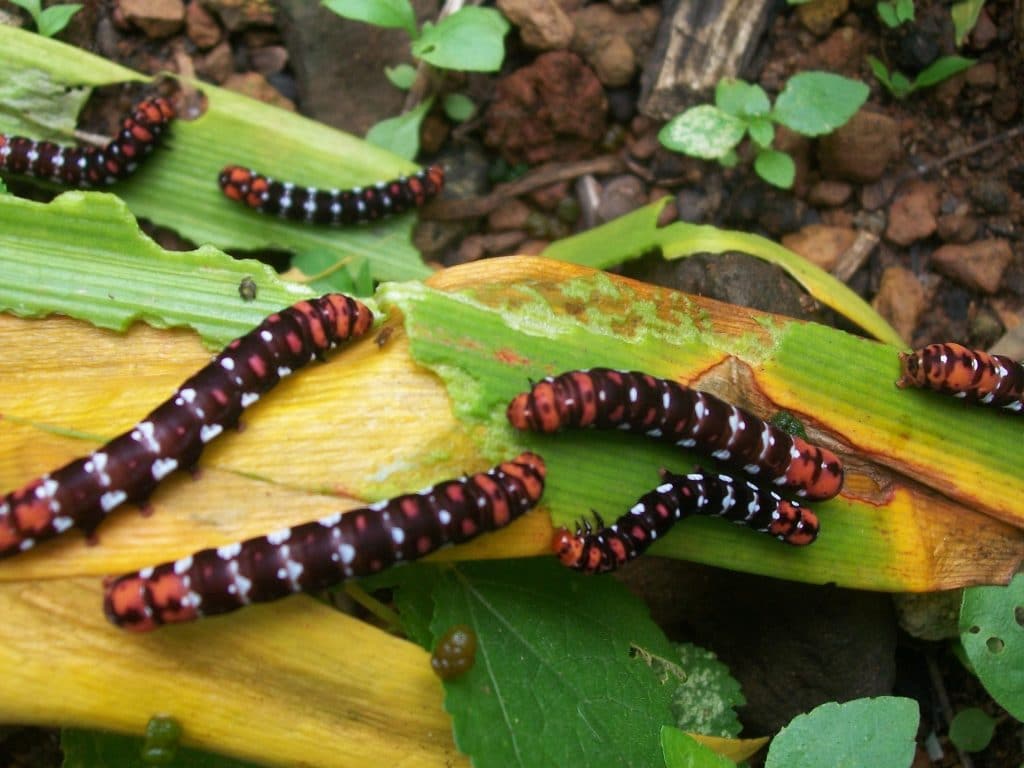Armyworms are pests that can eat through your lawn or garden in just a couple of days. The older they get, the more they devour, and they move through an area in large numbers.
They can be stopped with certain synthetic chemicals and natural remedies. You can also try reading gardening blogs while taking preventive measures to keep these rascals away.
Conquering Armyworms in Your Lawn or Garden
Armyworms are pests that devour grass. Sometimes it infests even the leaves of vegetables like cabbage, carrots, beans, corn, and turnips. They get their name from the way they move through an area in large numbers in a military-like fashion.
Armyworms can cause considerable damage to your precious lawn or garden. But there are many options for getting rid of them.
Just What Are Armyworms?

Image: Public Domain US, USGS Bee Inventory and Monitoring Lab, Flickr
Armyworms go through four life stages.
- They begin as eggs that look like tiny white beads.
- After a week or two, they hatch into a larva or caterpillar. These insects are striped and can be shades of green, orange, yellow and brown. Their legs have a dark stripe on the side. Mature larvae can grow as long as 1 1/2 inches. They stay caterpillars for several weeks.
- Then the larva becomes a pupa, enclosed in a brown shell. It rests below the surface of the soil for about 10 days.
- The adult armyworm emerges as a light gray or light brown moth with a tiny white dot on its front wings. It can have a wingspan as large as 1 1/2 inches.
Armyworms are sensitive to weather conditions. They can only survive winter in warm places like the southern United States, and some even prefer to wait out the winter in tropical climates like the Caribbean.
In the spring, they head north and will often end up east of the Rocky Mountains. There are about 30 species of armyworms, but they all behave basically the same.
You’ll most likely see them from April to September and particularly after rain. Armyworms are generally active at night and hide in lush vegetation during the day.
There are usually at least three generations of armyworms each season, although warmer climates can see more. That means you may have to deal with two or three invasions throughout the spring and early fall.
Why Get Rid of Armyworms?

Image: CC by A-SA 3.0, JackFrost2121, via Wikipedia Commons
Armyworm caterpillars (larvae) harm the leaves of vegetables, grains, and grasses. Young armyworms will remove the green layer of leaves, while mature caterpillars chew through leaf edges and grass blades.
They can also make dents in your vegetables. While armyworms don’t typically kill a lawn or vegetable garden, they leave it looking ugly and damaged.
Young armyworms don’t consume that much, so it might not seem as though they’re doing much damage in the beginning. However, once they get over .75 inches long, they eat a lot more and they eat it quickly.
It can take them just a couple of days to work through your lawn or garden. Eating four times as much in that short period than they did before. What looked like a nuisance suddenly becomes a serious problem.
Armyworm eggs are also a problem because they turn into hungry caterpillars. As for adult armyworms (moths), they’re also best gotten rid of because they lay the eggs that turn into damaging larvae.
So while it’s only the caterpillar that will eat away at your lawn or garden, the armyworm is a pest in all of its forms.
Getting Rid of Armyworms

Image: CC by 2.0, Harry Rose, via Wikipedia Commons
Since various creatures can eat your grass or vegetable leaves, look for armyworms by doing the following:
- Check your lawn regularly for bald spots. Mature armyworms eat the blades right down to the crown.
- This remains as the place where the grass root and grass shoot meet.
- Look for caterpillars fitting the armyworm description under clumps of leaves or pockets of loose soil. They’ll be green, brown, orange, yellow or some combination with horizontal bands.
- If you catch sight of their legs, look for a dark stripe.
- If you want to be proactive, mix a gallon of water with a few tablespoons of dishwashing liquid. Pour it over an area where you think armyworms may be hiding, such as a bald patch in your lawn.
- This soapy solution makes the caterpillars uncomfortable, and you’ll see the soil stir as they move around beneath the surface.
Look for five or more caterpillars per square yard because that signals the need to be proactive in getting rid of them. There are several things you can do to accomplish this.
Manual Removal
If you can catch armyworms when they’re no more than .5 inches long, then you can limit the damage they do. Since their appetites grow as they age.
The simplest and cheapest method is to remove them by hand. Go out to your lawn at night with a flashlight to look for them. You can also use the dishwashing liquid recipe to force them out of the soil during the day.
Gather them by hand, and put them in a container with soapy water. Do this to dispose of them safely later.
This won’t guarantee that there aren’t more waiting to hatch, but at least you’ll know you’ve gotten rid of some of them.
Lawn Pesticides
An insecticide for lawns may get rid of your armyworms. Choose one that takes care of caterpillars.
Make sure it’s in spray form rather than granules. Because this form tends to work better with these pests on plants from lawn seeding.
Also, make sure you’re using an insect-killing formula that’s safe for fruit and vegetables. Do this if you’re spraying in or near a garden of edibles.
No products found.
Bacillus thuringiensis (Bt)
Accordingly, Bacillus thuringiensis (Bt) can help get rid of armyworms that are .5 inches long or less. The nice thing is that it doesn’t harm good insects in the process.
It might help to water your lawn or garden first to get the caterpillars out from hidden spaces in the soil. Spray it just before dark to get as close to their feeding time as possible.
Be aware, though, that Bt doesn’t last beyond a couple of days. So if you’re not seeing improvement, give your lawn or garden another Bt treatment.
No products found.
Neem Oil

Image: Public Domain US, R6, State & Private Forestry, Forest Health Protection, Flickr
If you prefer to use a natural pesticide, neem oil may be a good option. It comes from the neem tree and can be bought as an insect repellent.
Try a couple of tablespoons of neem oil in a gallon of water. Do this with a couple of tablespoons of dishwashing soap to keep the oil and water from separating. Continuously shake the bottle as you spray to keep the ingredients well mixed.
It’s not an instant solution, so spray it every week or two until your armyworm problem goes away. It’s safe for your edible garden too.
No products found.
Beneficial Nematodes
Primarily, beneficial nematodes are microscopic organisms that eat the eggs, larvae, and pupae of many pests, including armyworms. They’re also not harmful to beneficial insects, the soil, pets or people.
You can buy them in containers by the millions. Spread enough to cover the area where you think armyworms are feeding, and water the soil. It’s best to do this in the evening after the sun has gone down.
These creatures should start to do their work in 24 hours. You can even refrigerate them until the expiration date on the container for later use.
No products found.
Birds
We all know that birds enjoy snacking on armyworm caterpillars. So, it might not be a bad idea to position birdfeeders around your lawn or garden to attract them.
If you’re doing this in your vegetable garden, then be aware that some birds can be rough with seeds and sprouts. Therefore, put them out only once you’ve confirmed that you have an armyworm infestation.
Since armyworms like lush vegetation, at that point. Then, the birds probably won’t do much harm to your vegetables.
Other natural prevention methods also apply such as an enhanced inground water sprinkling system. Traveling and walking sprinklers goes with it. Also, using hydroponic fertilizer systems works fine as well.
Keeping Armyworms Away

Image: CC by A-SA 4.0, SHIRAS WC, via Wikipedia Commons
There are also things you can try to prevent armyworms from invading your lawn or garden in the first place. Ground beetles and rove beetles, both large families of beetles, are natural predators of the armyworm.
So are certain types of flies and wasps. Mice and squirrels also feast on armyworm larvae and pupae. The best thing you can do is to ensure you’re not using any insecticides.
Proper methods of watering them work just fine. Try other methods to keep these helpers out of your lawn or garden such as yard fertilizers.
Grassy weeds are a favorite place for armyworm moths to lay eggs, so try to control patches of weeds in your lawn. Make sure your garden is kept well weeded.
Like any moth, adult armyworms go after light sources. So you might want to keep your lawn and garden free of lamps or decorative lights.
You could also use a moth trap to catch adult armyworms. Look closely at them to see if they have a tiny white dot on each of their front wings.
This can tell you if you might have an armyworm egg problem. If so, monitor your lawn or garden leaves for tiny whitish clusters or rows of eggs.
Then, get rid of as many as you can. Armyworms are unpleasant pests to deal with because of their sheer numbers.
It can be upsetting to watch your beautiful lawn or vegetable garden damaged by these hungry critters.
Getting rid of them takes some effort. But, it’s worth it to keep your grass beautiful and your garden thriving.
Featured Image: Public Domain US, uacescomm, Flickr
Last update on 2024-04-26 at 18:38 / Affiliate links / Images from Amazon Product Advertising API